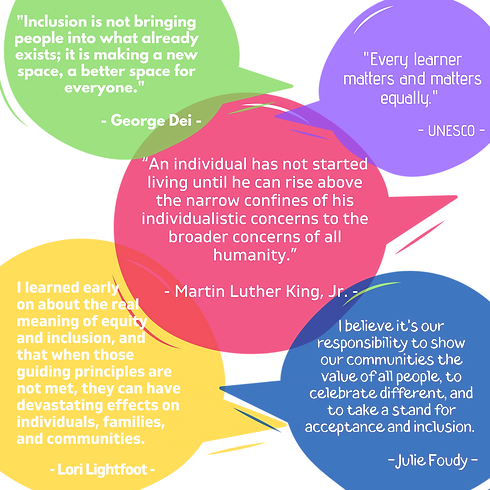
Inclusion:
Equal access and opportunity
We all want to feel included, valued and respected. Creating a truly inclusive school requires sensitivity, creativity and hard work but it is so worth it. One Big Classroom aims to support educators and non-educators alike in their journey toward making schools more inclusive.
Learn how our schools can create the kinds of learning environments that benefit all students who make their way through our doors.
What is Inclusion?
Inclusion in education is not a new idea. It is a celebration of learning, an appreciation for differences, and a recognition that we all have something to gain from each other. This means that children with different learning needs, abilities, triumphs and challenges have the same opportunities to learn. This does not mean that everyone is taught the same way but rather, that the school ensures that each child is given a fair chance to learn.
Inclusion assumes that the SCHOOL be made to fit the child, not that the child be made to fit the school.

Getting Started
Ready to see how you can make your school a more inclusive place for children? Test your skills through this Kahoot!
The 3 Tiered Approach
Inclusive schools typically use a 3-tiered approach to supporting exceptional children. Universal Design for Learning and Differentiation are at the foundation. Teachers use these two approaches to teaching to ensure that students' needs are met.

In the event that a child needs more help, more specialized support can be offered. This is often through accommodations like extra time, a scribe or reader to help work with text or specific tools like a recording device or braille books. This student may also receive some additional support from a Special Education Resource Teacher (SERT) in the classroom or through a more individualized setting.
Finally, for the child who needs a completely modified program or requires a great deal more assistance in and outside the classroom, the third tier allows for the creation of a specialized learning experience that is well supported and very individualized.
Have a look at this PowToon for a glimpse into how one teacher learned about differentiation and accommodations.


What Can I Do?
We've probably all felt like Jim or, perhaps, even more unsure of what to do.
When putting differentiation into practice, there are 4 main areas that we can consider:
-
Content (what we teach)
-
Process (how we teach)
-
Product (how the student shows understanding)
-
Environment (how the classroom supports the learner)
Making a change in one or more of these areas for a student or group of students allows us to differentiate for the various learners in our room. Considering these elements at the outset and creating a lesson that, from the onset, allows all learners to access what is happening, is called Universal Design. More on this later.
Have a look at some examples of the accommodations you can consider in each of the areas listed above.
